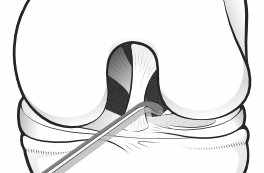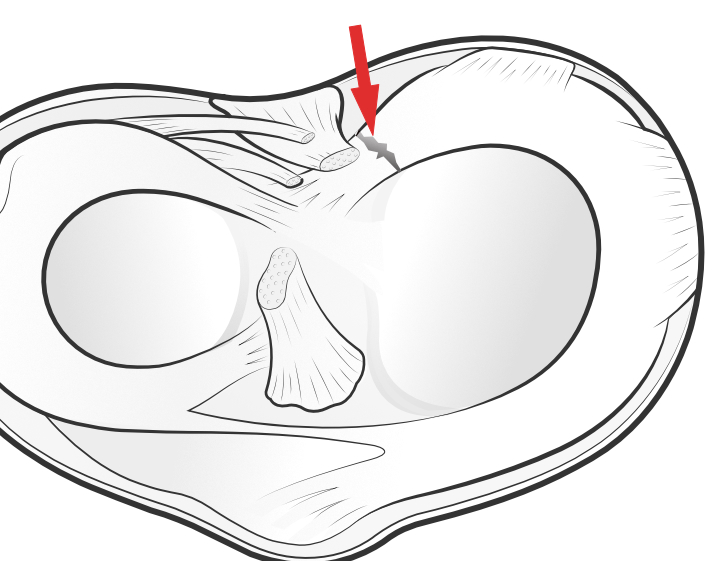A meniscal root tear is a tear of the knee meniscus close to the root region where the meniscus is anchored to the underlying bone.
 Page updated December 2023 by Dr Sheila Strover (Clinical Editor)
Page updated December 2023 by Dr Sheila Strover (Clinical Editor)

A probe being used to examine the integrity of the root area.

Looking down from the top, the illustration shows a radial tear through the body of the posterior horn of the meniscus at the root.
What is the meniscal root?
At the front and the back of the meniscus anchoring fibres extend down into the flattened top of the tibia, fixing these ends but allowing the body of the meniscus to move, so that one can twist without stressing the meniscus.
How serious is a meniscal root tear?
A meniscal root tear is a serious incident. The meniscus itself is not initially damaged, but the sudden instability caused by the root issue needs to be addressed urgently or else the excessive mobility of the meniscus will lead to it becoming irreparably damaged.
Meniscal root tears and knee instability
Meniscus root tears may be acute, where the tear occurs suddenly and is immediately associated with incompetence of the meniscus as a shock absorber.
Meniscal root tears and arthritis
In older people it may only be recognised when investigation of arthritis symptoms reveal a meniscal extrusion, with the meniscus slipping out over the edge of the tibia bone. Either situation may end up with the patient developing arthritis, but early recognition of an acute tear may result in referral to a specialist meniscus surgeon, and repair of the tear before arthritis is established.
Classification of meniscal root tears
Meniscal root tears are classified as Types 1-5 depending on the situation and extent of the tear.
Reference: LaPrade classification system of meniscal root tears
Quick links
Forum discussions
- "Medial Meniscus - Can it rip in two?"
Patients discuss complete radial tear of the meniscus and compare this with meniscal root tears.
Peer-reviewed papers
-
Quote:
"The patient should remain non-weight-bearing for a minimum of 6 weeks following a transtibial pull-out meniscus root repair. Passive range of motion exercises in a safe zone of 0º to 90º of flexion is initiated postoperative day 1. After 2 weeks, the patient can be advanced in their knee flexion as tolerated. Progressive advancement to full weight-bearing begins at 6 weeks."
Citation: Pache S, Aman ZS, Kennedy M, Nakama GY, Moatshe G, Ziegler C, LaPrade RF. Meniscal Root Tears: Current Concepts Review. Arch Bone Jt Surg. 2018 Jul;6(4):250-259. PMID: 30175171; PMCID: PMC6110430.
Relevant material -
Peer-reviewed papers -
- 2015 - Meniscal Root Tear Repair: Why, When and How? Authors: Bonasia DE et al. - and interpreted for you by Dr Sheila Strover (Clinical Editor)
- 2020 - Management of traumatic meniscus tears: the 2019 ESSKA meniscus consensus Authors: Kopf S et al. - and interpreted for you by Dr Sheila Strover (Clinical Editor)
- 2016 - Posterior meniscal root injuries Authors: Moatshe G et al. - and interpreted for you by Dr Sheila Strover (Clinical Editor)
Dr Robert LaPrade of the Steadman-Philippon Institute discusses the importance of the early recognition and repair of meniscal root tears. (Start video, then click box on right of video to jump to YouTube)